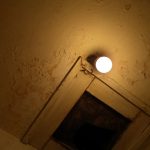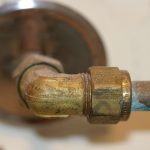Many people are already aware of what soap scum is, even if they are unfamiliar with that particular term. Soap scum is that white solid residue that you may find in areas of your bathroom, such as shower stalls, bathtubs, pipes and in the drain. This material is formed when soap is mixed with hard water that contains minerals like calcium and magnesium. In this article, we will take a detailed look at soap scum, examine how it affects our plumbing and how we can keep it out of our drains.
Soap Scum Can Cause Plumbing Problems
When the minerals that cause water hardness react with the fatty acids that are an ingredient in soap they create soap scum. This is also referred to as lime soap, and it can build up over time to create a sizable obstacle. Soap scum will attract mildew and mold, and it’s a particular threat to plumbing because it can block drains and pipes. It’s also a health hazard because it can act as a host for bacteria and promote its growth in your plumbing system. It is possible to find soap scum in a kitchen sink, but this problem is far more common in a bath or shower drain.
Water Hardness Issues
Soap scum can still form if the water supplied to your home is soft, but it’s far less likely. Sadly, most homes in our country are supplied with hard water that can mix with soap and easily form soap scum. It’s easy to notice if you’re supplied with hard water, there are some tell tale signs, such as water spots on washed drinking glasses, a need to use larger amounts of soap to achieve a lather and a build up of scale on fixtures and in water using appliances. This can be confirmed by carrying out a simple water hardness test at home. A water softener can be installed that will exchange water hardening mineral ions with sodium ions. This will make the water much softer and easier to work with on a daily basis. Having soft water in your home will also mean that you use less soap, and it will inhibit the formation of soap scum in your drains.
Preventing Soap Scum Clogs
As the old adage goes “prevention is better than the cure,” and this is true when it comes to many plumbing related issues. The best way to keep your drains clear of soap scum clogs is to prevent their formation in the first place. We’ve already mention installing a water softener earlier to make the formation of soap scum less likely. Here we will look at some cheap yet effective ways to keep your drain and pipes clear.
- Use Mesh Traps
A mesh trap is cheap to buy; you can get multiple traps and put them in every drain in your bathroom and kitchen. A mesh trap is a great way to catch soap scum before it can enter the drains. It’s also good at catching hair and other materials that can contribute to the formation of a clog.
- Take Care with Drains
Some people use their drains as a sort of garbage disposal, but anything that is put in the drain can combine with soap scum and create a clog. Materials, such as hair, grease, food and grooming products, will all combine easily with soap scum. The aforementioned mesh trap will help, but it’s also a good idea to put these waste materials in the trash where they belong.
Removing Soap Scum Clogs
It’s a great idea to clean out any soap scum that located in your drains. This should be done at least once each week to ensure that the clog cannot take hold and grow larger. Here are three proven methods that will help to keep soap scum out of your drains.
- Cleaning with Baking Soda
Take some baking soda and mix it with some clean water in a cup that you can then pour into the drain. Use a ratio of 1 tsp of baking soda for each gallon of water for the initial cleaning attempt. If this doesn’t work, move up to a ratio of 1 tsp of baking soda in a quart of water. This mixture is very effective at eating through soap scum, and the baking soda will also deodorize the drain making it clean and fresh. It’s important to only uses a maximum of 2 tsp of baking soda each day. So, if the two attempts detailed above don’t work, you need to wait and try again the next day. Using too much baking soda at once in your drain and pipes can damage the plumbing system.
- Pour in Some Boiling Water
Hot boiling water is very effective at melting hardened soap scum deposits. Simply boil up some water and pour it into the drain over the soap scum. Then you can follow up by running the hot water faucet for a few minutes to rinse any remaining residue away.
- Pour Ammonia in the Drain
Boiling hot water should shift most soap scum clogs, but if it doesn’t work, you can pour in some ammonia instead. Then you can follow this with some more boiling water and running the hot water faucet to finish. This is a good method to use if your drain has started to run slower because of a clog formed by soap scum deposits. It’s important to open up a window when you attempt this; ammonia odors can be overwhelming if the room isn’t well ventilated.
Some Cautionary Notes
If you use ammonia, don’t mix it with vinegar or a chlorine based bleach to make a cleaner. These chemicals mixed together can form a toxic gas that is extremely dangerous.
Don’t be tempted to use a commercial drain cleaning product to clear the soap scum from the drain. These granular, gel and liquid based products are often caustic in nature, and they can damage your plumbing pipes. These products don’t offer a long term solution to the problem, and the clog may return in a few weeks time.
If you have a persistent soap scum clog that you cannot remove it’s time to contact a
local professional certified plumber. They will have the experience and specialized tools to remove the blockage safely.
By Giovanni Longo President Flood Brothers Plumbing
Giovanni Longo is a 3rd generation master plumber who has been practicing his craft and trade in the greater Los Angeles area for well over a decade and a half. A plumbing and hydraulics-engineering innovator, Giovanni’s particular world-class expertise focuses on dealing with challenging sewer system designs as well as resolving complex commercial and residential draining issues. As a certified Flood Mitigation expert, he is also well versed in a wide variety of water damage and remediation solution.





